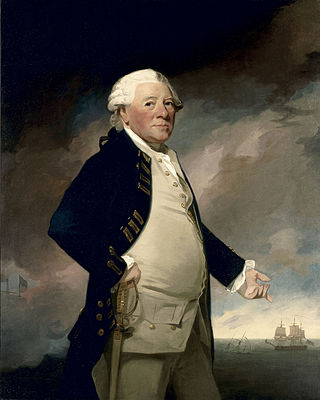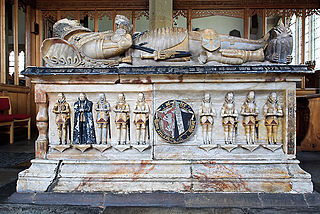
Earl of Stair is a title in the Peerage of Scotland. It was created in 1703 for the lawyer and statesman John Dalrymple, 2nd Viscount of Stair.

Baron Burton, of Burton-on-Trent and of Rangemore in the County of Stafford, is a title in the Peerage of the United Kingdom. It was created in 1897 for the prominent brewer, philanthropist and Liberal politician Michael Bass, 1st Baron Burton. He had already been created a baronet in 1882 and Baron Burton in 1886. However, the three titles had different remainders. The Bass family descended from William Bass, who founded the brewery business of Bass & Co in Burton upon Trent in 1777. His grandson Michael Thomas Bass transformed the company into one of the largest breweries in the United Kingdom. He also represented Derby in Parliament as a Liberal for thirty-five years and was a great benefactor to the town of Burton. However, Bass declined every honour offered to him, including a baronetcy and a peerage.
There have been six Baronetcies created for persons with the surname Brown, one in the Baronetage of Nova Scotia, one in the Baronetage of England, two in the Baronetage of Great Britain and two in the Baronetage of the United Kingdom. Two creations are extant as of 2010.

There have been two baronetcies created for members of the Knightley family, one in the Baronetage of England and one in the Baronetage of Great Britain. Both creations are extinct. The Knightley family originated at the Staffordshire manor of Knightley, acquired by them shortly after the Norman Conquest of 1066. In 1415 Sir Richard Knightley purchased the manor of Fawsley in Northamptonshire, where the senior line of the family became seated.
There have been two baronetcies created for people with the surname Heathcote, both in the Baronetage of Great Britain and both created in 1733. The holders of the first creation were later elevated to the peerage as Baron Aveland and Earl of Ancaster, which titles are now extinct. However, both baronetcies are extant as of 2008.
There have been three baronetcies created for persons with the surname Baillie, one in the Baronetage of Nova Scotia and two in the Baronetage of the United Kingdom. As of 2014 one creation is extant.

There have been seven baronetcies created for persons with the surname Parker, three in the Baronetage of England, two in the Baronetage of Great Britain and two in the Baronetage of the United Kingdom. Two of the creations are extant as of 2008. Though none of the different families of baronets were related, several supplied a number of flag officers to the Royal Navy.
There have been three baronetcies created for persons with the surname Bellingham, one in the Baronetage of England, one in the Baronetage of Ireland and one in the Baronetage of Great Britain. As of 2014 one creation is extant.
There have been six baronetcies created for persons with the surname Brooke, one in the Baronetage of England, one in the Baronetage of Ireland and four in the Baronetage of the United Kingdom. As of 2015 four of the creations are extant, though one has been subsumed into a peerage.
The Douglas of Glenbervie, Kincardine Baronetcy was created on 28 May 1625 in the Baronetage of Nova Scotia.

There have been four baronetcies created for persons with the surname Hope, three in the Baronetage of Nova Scotia and one in the Baronetage of the United Kingdom. As of 2010 one creation is extant, one dormant and two extinct.
There have been two baronetcies created for descendants of the ancient 12th-century border family of Heron of Ford Castle, Northumberland.
There have been two baronetcies created for persons with the surname Boyd, one in the Baronetage of Great Britain and one in the Baronetage of the United Kingdom.

There have been eight baronetcies created for persons with the surname Wilson, one in the Baronetage of Ireland and six in the Baronetage of the United Kingdom.
There have been three baronetcies created for members of the Mosley family, one in the Baronetage of England and two in the Baronetage of Great Britain. Only one creation is extant. Since 1980, the title has been held jointly with Baron Ravensdale in the Peerage of the United Kingdom.
There have been seven baronetcies created for persons with the surname Lawrence, one in the Baronetage of England, one in the Baronetage of Great Britain and five in the Baronetage of the United Kingdom.

There have been two baronetcies created for persons with the surname Matheson, both in the Baronetage of the United Kingdom. One creation is extant as of 2017.

There have been two baronetcies created for members of the Salusbury family, the first in the Baronetage of England and the second in the Baronetage of Great Britain. Neither title has survived to the present day although the senior baronetcy is technically considered to be dormant.
There have been two baronetcies created for persons with the surname Banks, on in the Baronetage of England and one in the Baronetage of Great Britain. Both creations became extinct on the death of the first holder.

The Hood baronetcy, of Tidlake in the County of Surrey, was created in the Baronetage of the United Kingdom on 13 April 1809 for Admiral Samuel Hood (1762–1814). He was a younger son of Samuel Hood (1715–1805) of Kingsland in the parish of Netherbury, Dorset, a purser in the Royal Navy and first cousin of the 1st Viscount Hood and the 1st Viscount Bridport. The baronetcy was created with remainder to his nephew Alexander Hood (1793–1851) of Wootton House, Butleigh, Somerset, and the heirs male of his body.









